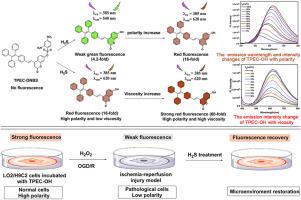当前位置:
X-MOL 学术
›
Anal. Chim. Acta
›
论文详情
Our official English website, www.x-mol.net, welcomes your
feedback! (Note: you will need to create a separate account there.)
An AIE-TICT fluorescence probe cascade responsive to H2S, polarity and viscosity to track microenvironment changes in cellular model of ischemia-reperfusion injury
Analytica Chimica Acta ( IF 5.7 ) Pub Date : 2024-11-14 , DOI: 10.1016/j.aca.2024.343425 Liguo Ji, Aoxiang Fu, Yuying Zhang, Ying Xu, Yanbei Xi, Shaoli Cui, Na Gao, Linlin Yang, Wanbing Shang, Zhijun Yang, Guangjie He
Analytica Chimica Acta ( IF 5.7 ) Pub Date : 2024-11-14 , DOI: 10.1016/j.aca.2024.343425 Liguo Ji, Aoxiang Fu, Yuying Zhang, Ying Xu, Yanbei Xi, Shaoli Cui, Na Gao, Linlin Yang, Wanbing Shang, Zhijun Yang, Guangjie He

|
Ischemia-reperfusion injury is a common cause of cardiovascular and cerebrovascular diseases. The reoxygenation during reperfusion leads to an overproduction of reactive oxygen species (ROS). As an antioxidant, H2 S can scavenge ROS to inhibit oxidative stress and inflammatory reaction, thus attenuating ischemia-reperfusion injury. In this process, the changes of cellular microenvironment (polarity or viscosity) have not been fully discussed. In order to real-time track the changes of cellular microenvironment during the treatment of ischemia-reperfusion injury with H2 S. It is necessary to develop highly selective and sensitive probes that can cascade response to hydrogen sulfide and cellular microenvironment.
中文翻译:

对 H2S、极性和粘度有反应的 AIE-TICT 荧光探针级联反应,用于跟踪缺血再灌注损伤细胞模型中的微环境变化
缺血再灌注损伤是心脑血管疾病的常见原因。再灌注过程中的再氧合导致活性氧 (ROS) 的过量产生。作为一种抗氧化剂,H2S 可以清除 ROS 以抑制氧化应激和炎症反应,从而减轻缺血再灌注损伤。在这个过程中,细胞微环境 (极性或粘度) 的变化尚未得到充分讨论。为了实时跟踪 H2S 治疗缺血再灌注损伤过程中细胞微环境的变化。有必要开发能够级联响应硫化氢和细胞微环境的高选择性和灵敏探针。
更新日期:2024-11-14
中文翻译:

对 H2S、极性和粘度有反应的 AIE-TICT 荧光探针级联反应,用于跟踪缺血再灌注损伤细胞模型中的微环境变化
缺血再灌注损伤是心脑血管疾病的常见原因。再灌注过程中的再氧合导致活性氧 (ROS) 的过量产生。作为一种抗氧化剂,H2S 可以清除 ROS 以抑制氧化应激和炎症反应,从而减轻缺血再灌注损伤。在这个过程中,细胞微环境 (极性或粘度) 的变化尚未得到充分讨论。为了实时跟踪 H2S 治疗缺血再灌注损伤过程中细胞微环境的变化。有必要开发能够级联响应硫化氢和细胞微环境的高选择性和灵敏探针。


















































 京公网安备 11010802027423号
京公网安备 11010802027423号